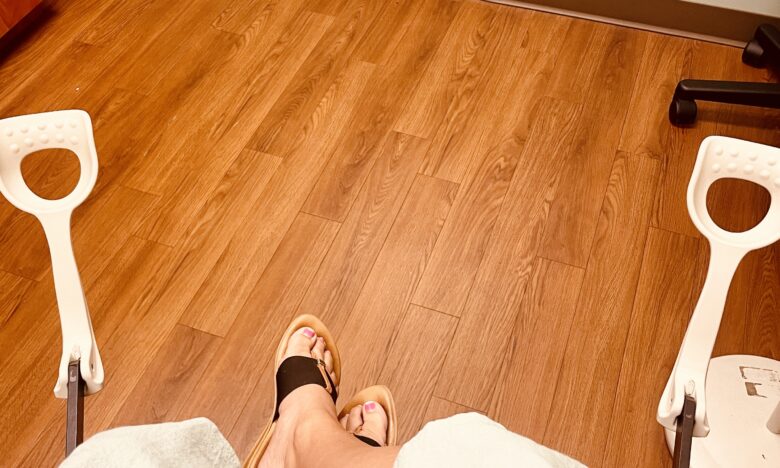80% of Women Will Develop a Uterine Fibroid(s) by Age 50
A reminder to tune into the wisdom of our bodies.
According to the U.S. National Institute of Health (NIH), 20-25% of women of reproductive age have fibroids. By the age of 50, up to 80% of black women and up to 70% of white women have fibroids.
Even though that is a huge number of the population, I didn’t know much, if anything, about fibroids until I learned that I had a large one that would need to be surgically removed.
Back in March, I went to the ER for pain around my belly button that wasn’t going away, along with a heaviness in my pelvis that resembled the third trimester pressure I experienced with my three babies. It was uncomfortable to walk. I laid around on the couch for 24 hours thinking it would pass, but the pressure and intensity kept increasing. I seriously thought it might be my appendix due to the location of pain around my belly button. The ER doctor had the same concerns and ordered an MRI and told me what the next steps would be if it was my appendix.
It wasn’t my appendix. It was diverticulitis, which the doctor said could still cause complications if one of the intestinal pockets ruptured. My orders were to rest, watch my diet, and take the antibiotics he prescribed.
“Oh,” he then said walking towards the curtain of the ER room, “You also have a 10.5 cm uterine fibroid. They are common though.”
As he disappeared behind the curtain, Dwayne held up his thumb and pointer finger as if measuring something. “That’s about five inches,” he said. “Is it five inches this way or this way?” He moved his fingers horizontally and vertically. I didn’t have any idea and I didn’t really care. I was in pain, and it was the day before Easter. I was to host our family and parents, and my brother and sister-in-law. I didn’t have time for pain or a fibroid of any size.
I contacted my gynecologist the following week, just to let her know. The nurse said that was a large fibroid and I needed to come in. Thus began a series of tests and procedures to map out the location and type of fibroid.
It turns out I actually have four fibroids. The large one, which measured larger (or more accurately) at 12.14 with an ultrasound, was the one of most concern due to its size and location. The doctor said it was the size of a melon or a baby’s head, whichever I preferred, and that it was located on top of my uterus and extended into my abdomen, directly behind my belly button.
For the record, I preferred neither a melon nor a baby’s head in either my uterus or my abdomen.
My gynecologist discussed options with me. With this size fibroid there were really only two options: leave it and live with it, which isn’t really advised, or have a hysterectomy. We decided on the latter since I wasn’t planning on having anymore children.
Next, we had to rule out the possibility of cancer. Uterine fibroids, or leiomyomas, are tumors or growths made of smooth muscle cells. They are typically noncancerous, but since I had precancerous cells removed from my uterus after my first baby, and the recent ultrasound my gynecologist ordered showed endometrial thickening, we needed to rule out cancer with a biopsy. And thank goodness we did rule it out.
Researchers are still not sure exactly what causes fibroids, but genetics, estrogen and progesterone, growth hormones, vitamin D deficiency, and major stresses are all suspected to play a role.
I’m currently working with a functional medicine doctor to learn more about my own body, including my hormone levels and any other indicators which might be at play. I am scheduled to complete more tests within the coming weeks to gather baseline information about my hormone levels prior to surgery.
Many women go on hormone replace therapy (HTR) after a hysterectomy because the removal of the ovaries can trigger menopause. Luckily, my gynecologist hopes to leave my ovaries intact. Still, my functional medicine doctor wants to look at my levels pre- and post-surgery to determine what is best for me and the lifestyle I want to have going forward.
If you or someone you love has had heavy bleeding or painful periods, been anemic, had bleeding between periods, experienced a “full” feeling in the lower abdomen (this is sometimes called pelvic pressure), frequent urination (caused by a fibroid pressing on the bladder), pain during sex, lower back pain, reproductive problems, such as infertility, multiple miscarriages, or early onset of labor during pregnancy, encourage them to discuss these issues with their doctor, as there may be treatments or options to help with a better quality of life and reduce symptoms. For more information, click here: https://www.nichd.nih.gov/health/topics/uterine/conditioninfo/symptoms
Women’s health matters. You matter! Your health and wellness matter!
On my initial visit with the gynecologist, I asked about how we had missed a fibroid of this size, especially given I’ve kept my yearly check-ups since the pre-cancerous cells that were found after my first child. Her response was a reminder about the location on top of the uterus, followed by a light-hearted comment about not listening to my body.
Of course, she was right. I don’t always listen to my body. I feel safe in saying many women and men don’t. We are busy doing all the things. It takes a diagnosis, disease – an unexpected death for us to slow down and tune in.
Let’s not wait for that to be the case. Let’s trust that our bodies are designed to guide us, whether that be with gut instincts or emotions or physical symptoms. We know what we need.
Your physical well–being, material well–being, social well–being, emotional well–being, and development and activity are all interlinked. It’s important we ask questions and learn about our bodies so we can make educated decisions that keep us functioning optimally. After all, the ultimate goal is a full and meaningful life, and these bodies are our vehicle on this wild and beautiful ride.
Have you or someone you loved been diagnosed with uterine fibroids? I’d love to know your experience, your research and discoveries, and your outcomes in how you manage fibroids and your health.








